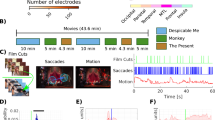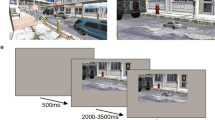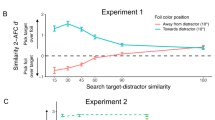Abstract
Little is known about how attention changes the cortical representation of sensory information in humans. On the basis of neurophysiological evidence, we hypothesized that attention causes tuning changes to expand the representation of attended stimuli at the cost of unattended stimuli. To investigate this issue, we used functional magnetic resonance imaging to measure how semantic representation changed during visual search for different object categories in natural movies. We found that many voxels across occipito-temporal and fronto-parietal cortex shifted their tuning toward the attended category. These tuning shifts expanded the representation of the attended category and of semantically related, but unattended, categories, and compressed the representation of categories that were semantically dissimilar to the target. Attentional warping of semantic representation occurred even when the attended category was not present in the movie; thus, the effect was not a target-detection artifact. These results suggest that attention dynamically alters visual representation to optimize processing of behaviorally relevant objects during natural vision.
This is a preview of subscription content, access via your institution
Access options
Subscribe to this journal
Receive 12 print issues and online access
$209.00 per year
only $17.42 per issue
Buy this article
- Purchase on Springer Link
- Instant access to full article PDF
Prices may be subject to local taxes which are calculated during checkout







Similar content being viewed by others
References
Olshausen, B.A., Anderson, C.H. & Van Essen, D.C. A neurobiological model of visual attention and invariant pattern recognition based on dynamic routing of information. J. Neurosci. 13, 4700–4719 (1993).
Luck, S.J., Chelazzi, L., Hillyard, S.A. & Desimone, R. Neural mechanisms of spatial selective attention in areas V1, V2, and V4 of macaque visual cortex. J. Neurophysiol. 77, 24–42 (1997).
McAdams, C.J. & Maunsell, J.H. Effects of attention on orientation-tuning functions of single neurons in macaque cortical area V4. J. Neurosci. 19, 431–441 (1999).
Reynolds, J.H., Pasternak, T. & Desimone, R. Attention increases sensitivity of V4 neurons. Neuron 26, 703–714 (2000).
David, S.V., Hayden, B.Y., Mazer, J.A. & Gallant, J.L. Attention to stimulus features shifts spectral tuning of V4 neurons during natural vision. Neuron 59, 509–521 (2008).
Connor, C.E., Preddie, D.C., Gallant, J.L. & Van Essen, D.C. Spatial attention effects in macaque area V4. J. Neurosci. 17, 3201–3214 (1997).
Asaad, W.F., Rainer, G. & Miller, E.K. Task-specific neural activity in the primate prefrontal cortex. J. Neurophysiol. 84, 451–459 (2000).
Warden, M.R. & Miller, E.K. Task-dependent changes in short-term memory in the prefrontal cortex. J. Neurosci. 30, 15801–15810 (2010).
Johnston, K. & Everling, S. Neural activity in monkey prefrontal cortex is modulated by task context and behavioral instruction during delayed-match-to-sample and conditional prosaccade-antisaccade tasks. J. Cogn. Neurosci. 18, 749–765 (2006).
Mazer, J.A. & Gallant, J.L. Goal-related activity in V4 during free viewing visual search. Evidence for a ventral stream visual salience map. Neuron 40, 1241–1250 (2003).
Huth, A.G., Nishimoto, S., Vu, A.T. & Gallant, J.L. A continuous semantic space describes the representation of thousands of object and action categories across the human brain. Neuron 76, 1210–1224 (2012).
Peelen, M.V., Li, F.F. & Kastner, S. Neural mechanisms of rapid natural scene categorization in human visual cortex. Nature 460, 94–97 (2009).
Li, F.F., VanRullen, R., Koch, C. & Perona, P. Rapid natural scene categorization in the near absence of attention. Proc. Natl. Acad. Sci. USA 99, 9596–9601 (2002).
O'Craven, K.M., Downing, P.E. & Kanwisher, N. fMRI evidence for objects as the units of attentional selection. Nature 401, 584–587 (1999).
Reddy, L. & Kanwisher, N. Category selectivity in the ventral visual pathway confers robustness to clutter and diverted attention. Curr. Biol. 17, 2067–2072 (2007).
Bartels, A. & Zeki, S. Functional brain mapping during free viewing of natural scenes. Hum. Brain Mapp. 21, 75–85 (2004).
Hasson, U., Nir, Y., Levy, I., Fuhrmann, G. & Malach, R. Intersubject synchronization of cortical activity during natural vision. Science 303, 1634–1640 (2004).
Kay, K.N., Naselaris, T., Prenger, R.J. & Gallant, J.L. Identifying natural images from human brain activity. Nature 452, 352–355 (2008).
Nishimoto, S. et al. Reconstructing visual experiences from brain activity evoked by natural movies. Curr. Biol. 21, 1641–1646 (2011).
Naselaris, T., Prenger, R.J., Kay, K.N., Oliver, M. & Gallant, J.L. Bayesian reconstruction of natural images from human brain activity. Neuron 63, 902–915 (2009).
Mitchell, T.M. et al. Predicting human brain activity associated with the meanings of nouns. Science 320, 1191–1195 (2008).
Miller, G. WordNet: a lexical database for English. Commun. ACM 38, 39–41 (1995).
Benjamini, Y. & Yekutieli, D. The control of the false discovery rate in multiple testing under dependency. Ann. Stat. 29, 1165–1188 (2001).
Corbetta, M. & Shulman, G.L. Control of goal-directed and stimulus-driven attention in the brain. Nat. Rev. Neurosci. 3, 201–215 (2002).
Carter, C.S. Anterior cingulate cortex, error detection and the online monitoring of performance. Science 280, 747–749 (1998).
Womelsdorf, T., Anton-Erxleben, K., Pieper, F. & Treue, S. Dynamic shifts of visual receptive fields in cortical area MT by spatial attention. Nat. Neurosci. 9, 1156–1160 (2006).
Haxby, J.V. et al. Distributed and overlapping representations of faces and objects in ventral temporal cortex. Science 293, 2425–2430 (2001).
Turin, G. An introduction to matched filters. IEEE Trans. Inf. Theory 6, 311–329 (1960).
Navalpakkam, V. & Itti, L. Search goal tunes visual features optimally. Neuron 53, 605–617 (2007).
David, S.V. & Gallant, J.L. Predicting neuronal responses during natural vision. Network 16, 239–260 (2005).
Acknowledgements
We thank D. Whitney for discussions regarding this manuscript. We also thank J. Gao, N. Bilenko, T. Naselaris, A. Vu and M. Oliver for their help in various aspects of this research. This work was supported by the National Eye Institute (EY019684 and EY022454) and the Center for Science of Information, a National Science Foundation Science and Technology Center, under grant agreement CCF-0939370.
Author information
Authors and Affiliations
Contributions
T.Ç. and S.N. designed the experiments. T.Ç. and A.G.H. operated the scanner. T.Ç. conducted the experiments and analyzed the data. T.Ç. and J.L.G. wrote the manuscript. J.L.G. provided guidance on all aspects of the project.
Corresponding author
Ethics declarations
Competing interests
The authors declare no competing financial interests.
Supplementary information
Supplementary Text and Figures
Supplementary Figures 1–13 and Supplementary Tables 1 and 2 (PDF 23321 kb)
Rights and permissions
About this article
Cite this article
Çukur, T., Nishimoto, S., Huth, A. et al. Attention during natural vision warps semantic representation across the human brain. Nat Neurosci 16, 763–770 (2013). https://doi.org/10.1038/nn.3381
Received:
Accepted:
Published:
Issue Date:
DOI: https://doi.org/10.1038/nn.3381
This article is cited by
-
Better models of human high-level visual cortex emerge from natural language supervision with a large and diverse dataset
Nature Machine Intelligence (2023)
-
History, Status, and Development of AI-Based Learning Science
SN Computer Science (2023)
-
Combining computational controls with natural text reveals aspects of meaning composition
Nature Computational Science (2022)
-
Voluntary control of semantic neural representations by imagery with conflicting visual stimulation
Communications Biology (2022)
-
A modeling framework for determining modulation of neural-level tuning from non-invasive human fMRI data
Communications Biology (2022)



